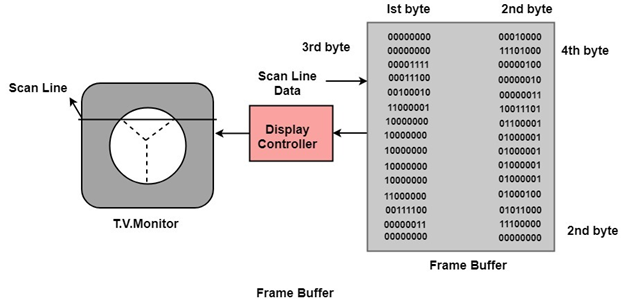Interactive and Passive Graphics
(a) Non-Interactive or Passive Computer Graphics:
In non-interactive computer graphics, the picture is produced on the monitor, and the user does not have any controlled over the image, i.e., the user cannot make any change in the rendered image. One example of its Titles shown on T.V.
Non-interactive Graphics involves only one-way communication between the computer and the user, User can see the produced image, and he cannot make any change in the image.
(b) Interactive Computer Graphics:
In interactive Computer Graphics user have some controls over the picture, i.e., the user can make any change in the produced image. One example of it is the ping-pong game.
Interactive Computer Graphics require two-way communication between the computer and the user. A User can see the image and make any change by sending his command with an input device.
Advantages:
- Higher Quality
- More precise results or products
- Greater Productivity
- Lower analysis and design cost
- Significantly enhances our ability to understand data and to perceive trends.
Working of Interactive Computer Graphics:
The modern graphics display is very simple in construction. It consists of three components:
- Frame Buffer or Digital Memory
- A Monitor likes a home T.V. set without the tuning and receiving electronics.
- Display Controller or Video Controller: It passes the contents of the frame buffer to the monitor.

Frame Buffer: A digital frame buffer is large, contiguous piece of computer memory used to hold or map the image displayed on the screen.
- At a minimum, there is 1 memory bit for each pixel in the raster. This amount of memory is called a bit plane.
- A 1024 x 1024 element requires 220 (210=1024;220=1024 x 1024)sq.raster or 1,048,576 memory bits in a single bit plane.
- The picture is built up in the frame buffer one bit at a time.
- ∵ A memory bit has only two states (binary 0 or 1), a single bit plane yields a black and white (monochrome display).
- As frame buffer is a digital device write raster CRT is an analog device.
Properties of Video Monitor:
1. Persistence: Persistence is the duration of phosphorescence. Different kinds of phosphors are available for use in CRT. Besides color, a major difference between phosphor in their persistence how they continue to emit light after the electron beam is removed.
2. Resolution: Use to describe the number of pixels that are used on display image.
3. Aspect Ratio: It is the ratio of width to its height. Its measure is unit in length or number of pixels.
Aspect Ratio =
